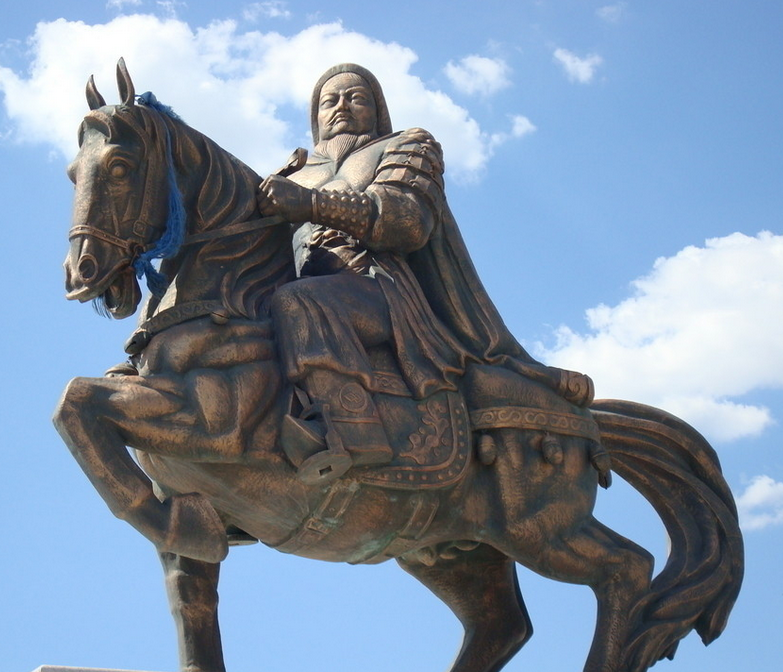(单词翻译:单击)
6.He was responsible for the deaths of as many as 40 million people.
6.他才是致死四千万人的罪魁祸首。
While it's impossible to know for sure how many people perished during the Mongol conquests, many historians put the number at somewhere around 40 million. Censuses from the Middle Ages show that the population of China plummeted by tens of millions during the Khan's lifetime, and scholars estimate that he may have killed a full three-fourths of modern-day Iran's population during his war with the Khwarezmid Empire. All told, the Mongols' attacks may have reduced the entire world population by as much as 11 percent.
虽然无法确切得知在蒙古征服的过程中有多少人死亡,很多历史学家认为人数大约在四千万。中世纪的人口调查显示,中国的人口在可汗生时锐减了成千上万,学者人们估计,在花刺子模的战争中,可汗也许杀掉了如今伊朗人数的四分之三。蒙古的袭击总计起来或许使全世界的人口减少了11%。
7.He was tolerant of different religions.
7.他包容各种宗教。
Unlike many empire builders, Genghis Khan embraced the diversity of his newly conquered territories. He passed laws declaring religious freedom for all and even granted tax exemptions to places of worship. This tolerance had a political side—the Khan knew that happy subjects were less likely to rebel—but the Mongols also had an exceptionally liberal attitude towards religion. While Genghis and many others subscribed to a shamanistic belief system that revered the spirits of the sky, winds and mountains, the Steppe peoples were a diverse bunch that included Nestorian Christians, Buddhists, Muslims and other animistic traditions. The Great Khan also had a personal interest in spirituality. He was known to pray in his tent for multiple days before important campaigns, and he often met with different religious leaders to discuss the details of their faiths. In his old age, he even summoned the Taoist leader Qiu Chuji to his camp, and the pair supposedly had long conversations on immortality and philosophy.
不像其他帝国缔造者那样,成吉思汗包容新征服地域的多样性。他通过法律称所有人都可以自由信仰宗教,甚至免去了朝圣地方的税。这种包容也是有政治性的——可汗明白心满意足的国民不会起来反抗——但是蒙古人也对宗教有着特殊的开放态度。成吉思以及其他人信仰召唤天、风和山的灵魂的萨满教,也有高原人民是信仰基督教、佛教、伊斯兰教或是信仰万物有灵论的。大可汗自己对精神灵魂也很有兴趣。众所周知,在重要的战争之前,他都会在帐篷中祈祷几日。他还经常和不同宗教的领袖见面,同他们探讨各自的信仰。他到了暮年时期,甚至召唤道家长老丘处机来他的营地,人们认为他们俩在长生不老和哲学问题上进行了深入的探讨。

8.He created one of the first international postal systems.
8.他创造了一种国际邮政系统。
Along with the bow and the horse, the Mongols most potent weapon may have been their vast communication network. One of his earliest decrees as Khan involved the formation of a mounted courier service known as the “Yam.” This medieval express consisted of a well-organized series of post houses and way stations strung out across the whole of the Empire. By stopping to rest or take on a fresh mount every few miles, official riders could often travel as far as 200 miles a day. The system allowed goods and information to travel with unprecedented speed, but it also acted as the eyes and ears of the Khan. Thanks to the Yam, he could easily keep abreast of military and political developments and maintain contact with his extensive network of spies and scouts. The Yam also helped protect foreign dignitaries and merchants during their travels. In later years, the service was famously used by the likes of Marco Polo and John of Plano Carpini.
除去弓和马,蒙古人最厉害的利器也许当数其广阔的通信网络。可汗最早下达的命令就是形成固定的信使服务也叫做牙木。这种原始快递由很多组织有序的驿舍以及遍穿整个土地的小站组成。官方的驿员可以隔几公里停下休息,这样他们每天可骑行320千米的路程。这个体系使得货物或信息能以很快的速度传递,同时它也作为可汗的眼和耳朵来观察情况。多亏了牙木,可汗能迅速了解军事和政治情况,并和广泛分布的间谍和侦察者们保持联系。牙木也在旅途中保护外国显要人物和商人的安全。在后来的几年,这个通道被马克·波罗和约翰·普兰诺·加宾尼这些人所利用。
9.No one knows how he died or where he is buried.
9.无人知道他是如何死的或埋葬在哪里。
Of all the enigmas surrounding the Khan's life, perhaps the most famous concerns how it ended. The traditional narrative says he died in 1227 from injuries sustained in a fall from a horse, but other sources list everything from malaria to an arrow wound in the knee. One of the more questionable accounts even claims he was murdered while trying to force himself on a Chinese princess. However he died, the Khan took great pains to keep his final resting place a secret. According to legend, his funeral procession slaughtered everyone they came in contact with during their journey and then repeatedly rode horses over his grave to help conceal it. The tomb is most likely on or around a Mongolian mountain called Burkhan Khaldun, but to this day its precise location is unknown.
关于可汗的一生有很多谜团,也许众人最关心的就是他是如何死的。传统说法是他死于1227年,从马背上掉下来被踩死的,但还有其他各种说法,从疟疾到膝盖中箭。还有最可疑的记录称他是在强行霸占一位公主时死的。不管是如何死的,可汗费了好大劲才使自己的安息地不为任何人所知。传说,他的送葬队伍杀死了每个在送葬路上碰到的人,随后骑着马反复在可汗墓地上行走踏平来掩盖痕迹。墓地很有可能在哈勒顿山上或其附近,但是至今都没人知道确切地点。
10.The Soviets tried to snuff out his memory in Mongolia.
10.前苏联试图抹掉可汗在蒙古的痕迹。
Genghis Khan is now seen as a national hero and founding father of Mongolia, but during the era of Soviet rule in the 20th century, the mere mention of his name was banned. Hoping to stamp out all traces of Mongolian nationalism, the Soviets tried to suppress the Khan's memory by removing his story from school textbooks and forbidding people from making pilgrimages to his birthplace in Khentii. Genghis Khan was eventually restored to Mongolian history after the country won independence in the early 1990s, and he's since become a recurring motif in art and popular culture. The Great Khan lends his name to the nation's main airport in the city of Ulan Bator, and his portrait even appears on Mongolian currency.
成吉思汗现在被认为是蒙古的开国英雄,但是在前苏联统治的19世纪,是决不允许提起可汗的名字的。苏联人妄图抹掉蒙古民族主义的所有痕迹,就试图从教科书上删掉他的事迹,并禁止人们在他的出生地肯特山进行朝奉,以此让人们忘记可汗这段历史。不过在20世纪90年代初,蒙古获得独立后,成吉思汗最终又出现在蒙古历史记载中。自此,他重新出现在艺术和流行文化中。如今,位于乌兰巴托的主要机场就是以大可汗的名字命名的,他的肖像甚至出现在蒙古的货币上。
翻译:汤汤 来源:前十网


